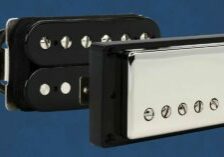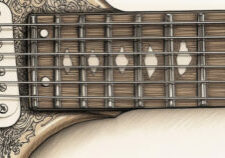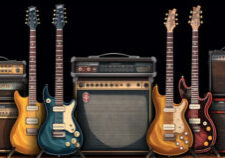Introduction
Amplifiers are an essential component of any audio system, but they can sometimes develop problems that affect their performance. Common issues include noise, tube failure, and other malfunctions that can impact the sound quality. In this guide, we will discuss how to diagnose and fix these common amp problems to ensure that your audio system is working at its best.
Identifying Common Amp Problems
As a musician, your amplifier is one of the most important pieces of equipment you own. It’s what allows you to project your sound and connect with your audience. However, like any piece of technology, amplifiers can experience problems that can affect their performance. In this article, we’ll discuss some common amp problems and how to diagnose and fix them.
One of the most common issues with amplifiers is noise. This can be caused by a variety of factors, including faulty cables, dirty pots or switches, or even interference from other electronic devices. To diagnose the problem, start by unplugging all cables from your amp and turning it on. If the noise persists, it’s likely an internal issue with the amp itself.
To fix the problem, start by cleaning any dirty pots or switches with contact cleaner. If that doesn’t work, try replacing any faulty cables or moving your amp to a different location to avoid interference from other electronics. If none of these solutions work, it may be time to take your amp to a professional for repair.
Another common issue with amplifiers is tube failure. Tubes are an essential component of many amps and can wear out over time. Symptoms of tube failure include a loss of volume or tone quality, as well as crackling or popping sounds.
To diagnose tube failure, start by visually inspecting the tubes for signs of damage or wear. If you notice any cracks or discoloration on the tubes, they may need to be replaced. You can also use a multimeter to test the tubes’ voltage levels and compare them to the manufacturer’s specifications.
If you determine that one or more tubes need to be replaced, make sure to use the correct type and rating for your amp. You can find this information in your amp’s manual or by contacting the manufacturer directly. When replacing tubes, make sure to handle them carefully and follow proper safety procedures.
Another issue that can affect amplifier performance is overheating. This can be caused by a variety of factors, including inadequate ventilation or a malfunctioning fan. Symptoms of overheating include a loss of volume or tone quality, as well as the amp shutting off unexpectedly.
To diagnose overheating, start by checking the amp’s ventilation system. Make sure that any vents or fans are clear of dust and debris and that there is adequate space around the amp for air to circulate. If the problem persists, it may be time to take your amp to a professional for repair.
In conclusion, amplifiers are essential pieces of equipment for musicians, but they can experience problems that can affect their performance. By understanding common amp problems and how to diagnose and fix them, you can keep your amp in top condition and ensure that your music sounds its best. Remember to always follow proper safety procedures when working with electronics and consult a professional if you’re unsure about any repairs.
Troubleshooting Noise Issues in Amplifiers
Amplifiers are an essential component of any sound system, whether it’s for a live performance or a home entertainment setup. However, like any electronic device, amplifiers can experience problems that affect their performance. One of the most common issues that people encounter with amplifiers is noise.
Noise in an amplifier can be caused by a variety of factors, including faulty components, poor grounding, and interference from other electronic devices. If you’re experiencing noise issues with your amplifier, there are several steps you can take to diagnose and fix the problem.
The first step in troubleshooting noise issues in amplifiers is to identify the source of the noise. Is the noise coming from the speakers or from the amplifier itself? If the noise is coming from the speakers, it could be caused by a problem with the wiring or a damaged speaker. If the noise is coming from the amplifier, it’s likely caused by an internal issue.
Once you’ve identified that the noise is coming from the amplifier, the next step is to check all of the connections and cables. Make sure that all of the cables are securely plugged in and that there are no loose connections. If you’re using a guitar amplifier, make sure that your guitar cable is in good condition and that it’s not picking up interference from other sources.
If checking the connections doesn’t solve the problem, it’s time to start looking at the internal components of the amplifier. One common cause of noise in amplifiers is a faulty tube. Tubes are responsible for amplifying the signal in many types of amplifiers, and if they fail or become damaged, they can produce unwanted noise.
To check if a tube is causing your noise issues, you’ll need to open up your amplifier and visually inspect each tube. Look for signs of damage or wear on the tubes, such as cracks or discoloration. You can also use a multimeter to test each tube for continuity and resistance.
If you find that a tube is faulty, you’ll need to replace it. Tubes are relatively easy to replace, but it’s important to make sure that you’re using the correct type of tube for your amplifier. Consult your amplifier’s manual or a professional technician if you’re unsure which type of tube to use.
Another common cause of noise in amplifiers is poor grounding. Grounding is essential for reducing noise and interference in electronic devices, and if your amplifier isn’t properly grounded, it can produce unwanted noise.
To check if your amplifier is properly grounded, you’ll need to use a multimeter to test the resistance between the ground pin on the power cord and the chassis of the amplifier. If there’s no continuity or a high resistance reading, you may need to rewire the ground connection or replace the power cord.
In some cases, noise issues in amplifiers can be caused by interference from other electronic devices. This can be particularly problematic in home entertainment setups where multiple devices are connected to the same power source.
To reduce interference from other devices, try unplugging any unnecessary devices from the same power source as your amplifier. You can also try using a power conditioner or surge protector to filter out unwanted noise and interference.
In conclusion, noise issues in amplifiers can be frustrating, but they’re often easy to diagnose and fix. By following these steps and taking a systematic approach to troubleshooting, you can identify and resolve most common amp problems quickly and easily. If you’re still experiencing issues after trying these solutions, it may be time to consult a professional technician for further assistance.
Diagnosing Tube Failure in Amplifiers
When it comes to diagnosing and fixing common amp problems, one of the most common issues that guitarists encounter is tube failure. Tubes are an essential component of any amplifier, and when they fail, they can cause a range of problems, from noise and distortion to complete loss of sound. In this article, we’ll take a closer look at how to diagnose tube failure in amplifiers and what steps you can take to fix the problem.
The first step in diagnosing tube failure is to listen carefully to your amplifier. If you notice any unusual noises or distortion, this could be a sign that one or more tubes are failing. Common symptoms of tube failure include crackling or popping sounds, hissing or buzzing noises, and a loss of volume or clarity.
Once you’ve identified the symptoms of tube failure, the next step is to visually inspect your amplifier’s tubes. Start by turning off your amplifier and unplugging it from the power source. Then, carefully remove the back panel or chassis cover to gain access to the tubes.
Inspect each tube carefully for signs of damage or wear. Look for cracks or breaks in the glass envelope, discolored or burned areas on the metal pins or plates, and signs of corrosion or rust. If you notice any of these signs, it’s likely that the tube has failed and will need to be replaced.
If you’re not sure whether a particular tube has failed, you can use a multimeter to test its electrical conductivity. Set your multimeter to measure resistance and touch the probes to the pins on either end of the tube. A healthy tube should show a low resistance reading (typically between 100-500 ohms), while a failed tube will show an open circuit (infinite resistance).
Once you’ve identified which tubes have failed, it’s time to replace them. Start by purchasing replacement tubes that are compatible with your amplifier’s make and model. You can find this information in your amplifier’s user manual or by contacting the manufacturer.
To replace a tube, start by turning off your amplifier and unplugging it from the power source. Then, carefully remove the old tube by gently pulling it out of its socket. Be sure to handle the tube carefully, as they can be fragile and easily damaged.
Next, insert the new tube into the socket, making sure that it’s seated firmly and securely. Be sure to match the pins on the tube with the corresponding holes in the socket. Once you’ve installed all of the new tubes, replace the back panel or chassis cover and plug your amplifier back in.
Finally, turn on your amplifier and test it to make sure that the tube replacement has solved the problem. If you’re still experiencing issues, it’s possible that there may be other underlying problems with your amplifier that need to be addressed.
In conclusion, diagnosing and fixing common amp problems like tube failure is an essential skill for any guitarist. By listening carefully to your amplifier, visually inspecting its tubes, and using a multimeter to test for electrical conductivity, you can quickly identify which tubes have failed and replace them with new ones. With a little bit of know-how and some basic tools, you can keep your amplifier running smoothly for years to come.
Fixing Hum and Buzz in Amplifiers
Amplifiers are an essential component of any sound system, whether it’s for a guitar, bass, or home theater. However, like any electronic device, they can experience problems that affect their performance. One of the most common issues with amplifiers is hum and buzz. These noises can be distracting and ruin the listening experience. Fortunately, there are ways to diagnose and fix these problems.
The first step in fixing hum and buzz in amplifiers is to identify the source of the noise. There are several possible causes of hum and buzz, including ground loops, faulty cables, and power supply issues. To determine the cause of the noise, start by unplugging all cables from the amplifier except for the power cord. If the noise persists, it’s likely a problem with the amplifier itself.
If the noise disappears when all cables are unplugged, start by plugging in one cable at a time until the noise returns. This will help you identify which cable is causing the problem. Once you’ve identified the culprit cable, replace it with a new one.
If the noise persists even with all cables unplugged, it’s likely a problem with the amplifier’s power supply. Check that the power cord is securely plugged into both the amplifier and the wall outlet. If this doesn’t solve the problem, try plugging the amplifier into a different outlet or using a power conditioner.
Another possible cause of hum and buzz in amplifiers is ground loops. Ground loops occur when there are multiple paths to ground in a sound system, causing electrical interference. To fix this issue, try using a ground loop isolator or lifting the ground on one of your devices.
If none of these solutions work, it’s possible that there’s a problem with one of your amplifier’s components. In particular, tube amplifiers can experience problems with tube failure or biasing issues. If you suspect that this is the case, it’s best to take your amplifier to a professional for repair.
In addition to hum and buzz, amplifiers can also experience other problems such as distortion, low output, and intermittent sound. These issues can be caused by a variety of factors, including faulty tubes, damaged components, or incorrect settings. To diagnose and fix these problems, start by checking the amplifier’s settings and ensuring that all cables are properly connected. If the problem persists, it may be necessary to replace or repair components within the amplifier.
In conclusion, diagnosing and fixing common amp problems requires a systematic approach. Start by identifying the source of the problem, whether it’s a faulty cable or a power supply issue. From there, try different solutions until you find one that works. If you’re unsure about how to fix the problem or suspect that there’s a more serious issue with your amplifier, it’s best to take it to a professional for repair. With proper care and maintenance, your amplifier can provide years of high-quality sound.
Repairing Power Supply Issues in Amplifiers
Amplifiers are an essential component of any sound system, whether it’s for a home theater or a live performance. However, like any electronic device, amplifiers can experience problems that affect their performance. One of the most common issues with amplifiers is power supply problems.
Power supply issues can manifest in different ways, such as noise, distortion, or complete failure to power on. In this article, we’ll discuss how to diagnose and fix common power supply problems in amplifiers.
The first step in diagnosing power supply issues is to check the power source. Make sure that the amplifier is plugged into a working outlet and that the power cord is not damaged. If the amplifier still doesn’t turn on, check the fuse. A blown fuse can cause the amplifier to fail to turn on or produce distorted sound.
If the fuse is intact and the amplifier still doesn’t turn on, it’s time to open up the amplifier and check for any visible damage. Look for burnt components or loose connections. If you find any damaged components, replace them with new ones.
Another common power supply issue is noise. Noise can be caused by a variety of factors, including ground loops, faulty cables, or interference from other electronic devices. To diagnose noise issues, start by disconnecting all input sources from the amplifier and turning up the volume. If you still hear noise, it’s likely caused by a problem with the amplifier itself.
To fix noise issues caused by ground loops, try using a ground loop isolator. This device separates the ground connection between two devices and can eliminate noise caused by ground loops. If faulty cables are causing noise issues, replace them with high-quality cables.
Tube amplifiers are particularly prone to power supply issues due to their reliance on vacuum tubes. Tube failure can cause distortion or complete loss of sound. To diagnose tube failure, start by checking each tube individually. Turn off the amplifier and let it cool down before removing the tubes. Inspect each tube for signs of damage, such as cracks or discoloration. If you find a damaged tube, replace it with a new one.
If all the tubes appear to be intact, the problem may be with the power supply circuitry. Check for any damaged components or loose connections in the power supply circuitry. If you find any issues, replace or repair them as necessary.
In conclusion, power supply issues are a common problem with amplifiers. To diagnose and fix these issues, start by checking the power source and fuse. If those are intact, check for visible damage inside the amplifier. Noise issues can be caused by ground loops or faulty cables, while tube failure can cause distortion or loss of sound. By following these steps, you can diagnose and fix common power supply problems in amplifiers and keep your sound system running smoothly.
Solving Overheating Problems in Amplifiers
Amplifiers are an essential component of any sound system, and they can be prone to a variety of problems. One of the most common issues that amplifier owners face is overheating. Overheating can cause a range of problems, from reduced sound quality to complete failure of the amplifier. In this article, we will discuss how to diagnose and fix common amp problems, with a focus on solving overheating problems in amplifiers.
The first step in diagnosing an overheating problem is to identify the symptoms. Symptoms of an overheating amplifier can include distortion or clipping, reduced volume, or even complete shutdown. If you notice any of these symptoms, it’s important to take action quickly to prevent further damage.
One common cause of overheating in amplifiers is inadequate ventilation. Amplifiers generate a lot of heat during operation, and if they are not properly ventilated, this heat can build up and cause damage. To address this issue, make sure that your amplifier is placed in a well-ventilated area with plenty of space around it. Avoid placing it in enclosed spaces or near other heat-generating equipment.
Another potential cause of overheating is a malfunctioning fan or cooling system. Many modern amplifiers come equipped with fans or other cooling systems to help dissipate heat during operation. If these systems are not functioning properly, the amplifier may overheat. Check your amplifier’s manual to see if it has a fan or other cooling system, and make sure that it is working correctly.
If inadequate ventilation or a malfunctioning cooling system are not the issue, then the problem may be related to the amplifier’s internal components. Over time, components such as capacitors and resistors can degrade or fail, which can cause the amplifier to overheat. If you suspect that this may be the case, it’s best to take your amplifier to a qualified technician for repair.
In some cases, tube failure can also cause an amplifier to overheat. Tubes are a critical component of many amplifiers, and if they fail, they can cause a range of problems, including overheating. If you suspect that your amplifier’s tubes may be failing, it’s best to take it to a qualified technician for diagnosis and repair.
In addition to these common causes of overheating, there are also some simple steps that you can take to prevent overheating in the first place. For example, make sure that your amplifier is not being overloaded with too much power. Overloading an amplifier can cause it to overheat and can also damage the internal components. Additionally, avoid using your amplifier for extended periods of time at high volumes, as this can also cause overheating.
In conclusion, overheating is a common problem in amplifiers, but it can be addressed with proper diagnosis and repair. If you notice any symptoms of overheating in your amplifier, such as distortion or reduced volume, take action quickly to prevent further damage. Check for inadequate ventilation or malfunctioning cooling systems, and consider taking your amplifier to a qualified technician for repair if necessary. By taking these steps and following some simple preventative measures, you can keep your amplifier running smoothly and avoid the headaches of overheating problems.
Addressing Distortion Issues in Amplifiers
Amplifiers are an essential component of any sound system, whether it’s for a home theater or a live performance. However, like any electronic device, amplifiers can experience problems that affect their performance. One of the most common issues with amplifiers is distortion, which can be caused by a variety of factors.
The first step in diagnosing and fixing distortion issues in amplifiers is to identify the type of distortion. There are several types of distortion, including harmonic distortion, intermodulation distortion, and clipping. Harmonic distortion occurs when the amplifier adds harmonics to the original signal, resulting in a distorted sound. Intermodulation distortion occurs when two or more signals mix together and create new frequencies that were not present in the original signal. Clipping occurs when the amplifier reaches its maximum output level and cuts off the peaks of the waveform.
Once you have identified the type of distortion, you can begin to troubleshoot the problem. One common cause of distortion is a faulty tube. Tubes are used in many amplifiers to amplify the signal, but they can wear out over time and need to be replaced. To check if a tube is faulty, you can use a tube tester or swap out tubes one at a time until you find the faulty one.
Another cause of distortion is improper gain staging. Gain staging refers to the process of setting the levels of each component in the signal chain to ensure that each component is operating at its optimal level. If one component is set too high or too low, it can cause distortion in the signal. To fix this issue, you should check each component in the signal chain and adjust their levels accordingly.
Grounding issues can also cause distortion in amplifiers. Grounding refers to connecting all components in the system to a common ground point to prevent electrical noise from interfering with the signal. If there is a grounding issue, it can cause hums or buzzes in the signal that can be mistaken for distortion. To fix this issue, you should check all grounding connections and ensure that they are properly connected.
Finally, improper speaker impedance can cause distortion in amplifiers. Speaker impedance refers to the resistance of the speaker to the electrical signal from the amplifier. If the speaker impedance is too low or too high, it can cause the amplifier to work harder than it should, resulting in distortion. To fix this issue, you should check the speaker impedance and ensure that it matches the amplifier’s output impedance.
In conclusion, diagnosing and fixing distortion issues in amplifiers requires a systematic approach to troubleshooting. By identifying the type of distortion and checking each component in the signal chain, you can pinpoint the source of the problem and take steps to fix it. Whether it’s a faulty tube, improper gain staging, grounding issues, or improper speaker impedance, addressing these issues will help ensure that your amplifier is operating at its optimal level and producing high-quality sound.
Preventing Common Amp Problems with Proper Maintenance
As a musician, your amplifier is one of the most important pieces of equipment you own. It’s what allows you to project your sound and connect with your audience. However, like any piece of equipment, amplifiers can experience problems that can affect their performance. In this article, we’ll discuss some common amp problems and how to diagnose and fix them.
One of the most common problems with amplifiers is noise. This can be caused by a variety of factors, including faulty cables, dirty pots or switches, or even interference from other electronic devices. To diagnose the problem, start by unplugging all cables from your amp and turning it on. If the noise persists, it’s likely an internal issue with the amp itself.
To fix the problem, start by cleaning all pots and switches with a contact cleaner. If this doesn’t work, try replacing any faulty cables or checking for any loose connections inside the amp. If none of these solutions work, it may be time to take your amp to a professional for repair.
Another common problem with amplifiers is tube failure. Tubes are an essential component of many amps and can wear out over time. Symptoms of tube failure include a loss of volume or tone quality, as well as crackling or popping sounds.
To diagnose tube failure, start by visually inspecting the tubes for any signs of damage or wear. If you notice any issues, try replacing the tubes with new ones. If this doesn’t solve the problem, it may be time to take your amp to a professional for further diagnosis.
Preventing Common Amp Problems with Proper Maintenance
While some amp problems are unavoidable, many can be prevented through proper maintenance. Here are some tips to keep your amp in top condition:
1. Keep it clean: Dust and dirt can build up inside your amp over time and affect its performance. Use a soft cloth to wipe down the exterior of your amp regularly and use compressed air to blow out any dust or debris inside.
2. Use the right cables: Using the wrong cables can cause noise and other issues with your amp. Make sure you’re using high-quality cables that are designed for your specific amp and instrument.
3. Store it properly: When not in use, store your amp in a cool, dry place away from direct sunlight and moisture. This will help prevent damage to the internal components and extend the life of your amp.
4. Get it serviced regularly: Even if your amp seems to be working fine, it’s a good idea to have it serviced by a professional every year or two. This will help catch any potential problems early on and keep your amp in top condition.
In conclusion, amplifiers are essential pieces of equipment for musicians, but they can experience problems that affect their performance. By understanding common amp problems and how to diagnose and fix them, as well as taking proper maintenance steps, you can keep your amp in top condition and ensure that it continues to deliver great sound for years to come.
Conclusion
Conclusion: To diagnose and fix common amp problems, it is important to first identify the issue by listening for any unusual sounds or checking for any visible damage. Once the problem has been identified, it is recommended to consult the amp’s manual or seek professional help if necessary. Some common fixes include replacing tubes, checking and tightening connections, and adjusting settings. Regular maintenance and proper handling can also prevent future issues from occurring.





